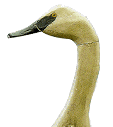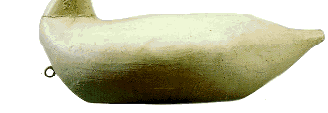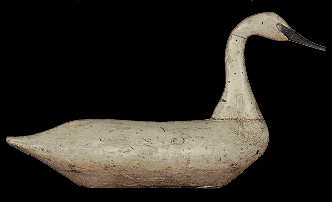by James L. Trimble
A long, sleek and graceful swan illustrates the cover of the Julia-Guyette September 1987 decoy auction catalog. Identified as a turn-of-the-century swan by Jim Cockey, it was made on Kent Island in Queen Anne's County, Maryland. The Maryland Historical Society produced a catalog for its decoy exhibit that premiered in 1991. It, too, featured a Cockey swan, an actual rigmate to the first, but undecided as to the swan's maker, they identified it as an unknown. |
 |
This elegant swan, featured on the catalog cover of Richard Oliver's October 1996 decoy auction, was identified as a 19th century swan by John Cockey, the patriarch of Queen Anne's County's most well-known family of decoy makers. |
 |
The Richard Oliver October 1996 decoy auction catalog featured a third example by the same maker, this one identified as a 19th century swan by John Cockey, Jim's father and patriarch of Queen Anne's County's best known family of decoy makers.
As evident by the variety of attribution given, most knowledgeable collectors agree that certain identification of the skillful hand that crafted these beautiful, yet functional, lures may forever remain a mystery. But whether these attractive decoys were made by the father or the son, their bold form and graceful style guarantee them a position among the finest swan decoys to have floated the Chesapeake Bay.
Today Kent Island is best known as the point where the 4 1/2-mile-long Chesapeake Bay Bridge connects U.S. 50 to Maryland's Eastern Shore. Over 12 long and 4 1/2 miles at his widest point, it is the largest island in the Chesapeake Bay. First colonized by English speaking settlers from Virginia's Jamestown settlement in 1631, its sovereignty was challenged a year later when Lord Baltimore arrived with war ships to enforce his claim that Kent Island belonged to Maryland. In 1657, after many skirmishes and numerous casualties, Virginia finally recognized Maryland's proprietary rights to the island.
 Prior to the completion of the first bay bridge in 1952, ferryboats shuttled autos from both Annapolis and Baltimore to Claiborne and Love Point on Kent Island's Chesapeake shoreline. The early ferries were steam-driven side-wheelers that eventually were replaced with larger screw-driven boats. When the auto ferry was established in 1919, Kent Island was still a rural farm community with a robust seafood industry that witnessed very few changes in its first 250 years of existence. It was only a matter of time before the twisting farm roads of Kent Island were straightened and paved so that Baltimore and Washington city-dwellers could more easily reach the Atlantic Coast's popular seashore resorts. Prior to the completion of the first bay bridge in 1952, ferryboats shuttled autos from both Annapolis and Baltimore to Claiborne and Love Point on Kent Island's Chesapeake shoreline. The early ferries were steam-driven side-wheelers that eventually were replaced with larger screw-driven boats. When the auto ferry was established in 1919, Kent Island was still a rural farm community with a robust seafood industry that witnessed very few changes in its first 250 years of existence. It was only a matter of time before the twisting farm roads of Kent Island were straightened and paved so that Baltimore and Washington city-dwellers could more easily reach the Atlantic Coast's popular seashore resorts.
For the complete story, please see the Jan./Feb. 2000 issue of Decoy Magazine.
Tidbits Main Index

|


